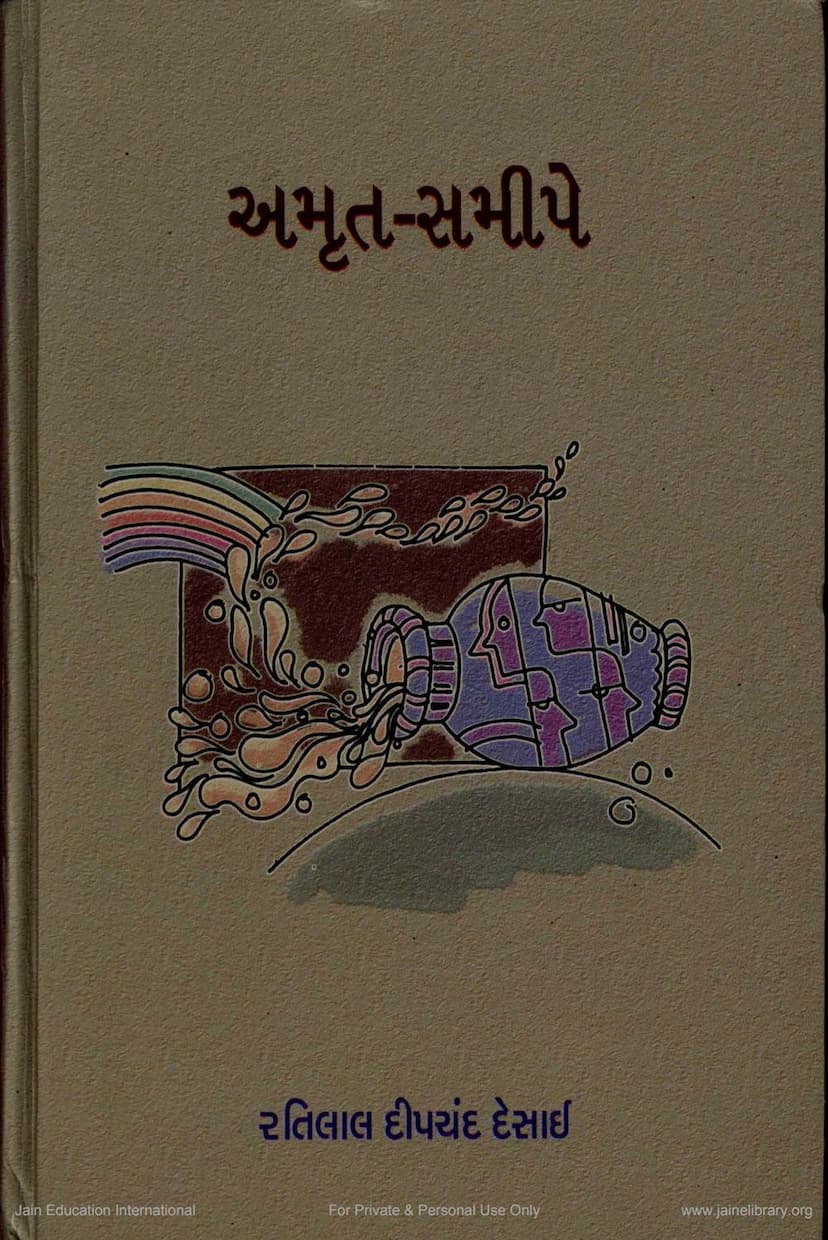Amrut Samipe
Added to library: September 1, 2025

Summary
This is a comprehensive summary of the Jain text "Amrut Samipe" based on the provided table of contents and excerpts.
Book Title: Amrut Samipe (અમૃત-સમીપે) Author: Ratilal Deepchand Desai (રતિલાલ દીપચંદ દેસાઈ) Publisher: Gurjar Granthratna Karyalay Catalog Link: https://jainqq.org/explore/001048/1
Overall Summary:
"Amrut Samipe" is a profound and expansive collection of essays, biographical sketches, and philosophical reflections penned by the late Ratilal Deepchand Desai. Published posthumously by Gurjar Granthratna Karyalay, the book, edited by his son Nitin R. Desai, is a testament to the author's deep engagement with Jain philosophy, ethics, and the lives of spiritual and intellectual luminaries. The text is a significant contribution to Jain literature, offering insights into the teachings, traditions, and key figures within Jainism, as well as broader Indian intellectual and cultural history.
The book is structured into several sections, each focusing on different aspects of Jain thought and biography:
Key Themes and Content:
-
The Author and His Philosophy: Ratilal Deepchand Desai is presented as a devout practitioner even while living a worldly life. His writings reflect his pure nature, simplicity, sincerity, and spirit of service. His inherent humility is evident in his refusal of prestigious titles and his simple requests for lower salaries when accepting roles. His life was characterized by detachment from possessions and a desire to serve others. He advocated for knowledge acquisition as the primary means to understand oneself and the universe, emphasizing the importance of sincere, selfless, and pure pursuit of knowledge.
-
Biographical Sketches of Scholars and Luminaries: A significant portion of the book comprises detailed biographical essays on prominent figures in Jain and broader Indian scholarship. This includes:
- Jain Scholars: Lives of influential figures like Shrimad Rajchandra, Pandit Sukhlalji, Muni Jinavijayji, Pandit Bechardasji, Veerchand Raghavji Gandhi, and many others are presented. These essays highlight their intellectual contributions, spiritual journeys, and dedication to preserving and propagating Jain knowledge.
- Other Scholars: The text also includes profiles of non-Jain scholars who contributed to Indian and Jain studies, such as Dr. Helmuth von Glasenapp, Prof. Paul Thieme, Dr. Schubing, and Prof. A. D. Pollock. This demonstrates Desai's broad intellectual curiosity and his recognition of universal scholarship.
- Jain Acharyas, Munis, and Sadhvis: The book delves into the lives and contributions of numerous Jain monks and nuns, detailing their ascetic practices, their scholarly pursuits, and their efforts in establishing and promoting Jain institutions and traditions.
-
Jain Philosophy and Teachings: The essays explore various facets of Jain philosophy, including discussions on the nature of the soul, karma, liberation (moksha), and the principles of non-violence (ahimsa) and non-absolutism (anekantavada). The author frequently connects these philosophical concepts to the practical lives of the individuals profiled.
-
Social and Cultural Commentary: Desai also touches upon societal issues, reformist tendencies within the Jain community, and the importance of education and ethical living. His writings often reflect a progressive outlook, advocating for rationalism and adapting religious teachings to contemporary times.
-
Literary Style and Approach: The author's writing style is described as insightful, detailed, accurate, fluent, and transparent, making complex philosophical ideas accessible to a wide readership. His extensive knowledge, encompassing Jain scriptures, other Indian philosophical traditions, and even external cultural events, is evident throughout. The essays often serve as a tribute, "gunasankirtan," to the individuals, offering a heartfelt "adhyar" (offering) of respect.
Structure and Scope:
The book is divided into 15 broad sections, covering over 600 pages and featuring approximately 500 articles. The sections include:
- Scholars of Jain Vidyā (pages 3-107)
- Other Scholars (pages 108-118)
- Jain Acharyas (pages 119-215)
- Jain Munis (pages 216-271)
- Jain Sadhvis (pages 272-288)
- Saints (pages 289-313)
- Educationists (pages 314-339)
- Journalists (pages 340-351)
- Literary Figures (pages 352-376)
- Artists (pages 377-394)
- Prominent Personalities (Shreshthis) (pages 395-460)
- Statesmen (pages 461-503)
- Devout Followers (pages 504-525)
- Social Workers (pages 526-608)
- Women of Eminence (pages 609-622)
- Addendum (Section 4)
Significance:
"Amrut Samipe" is a significant work for its comprehensive portrayal of individuals who shaped Jainism and contributed to Indian intellectual and cultural life. It serves as a valuable resource for understanding the depth of Jain scholarship, the lives of its revered figures, and the broader philosophical and social landscape of India. The author's dedication to meticulously researching and presenting these biographies is evident, offering readers a rich tapestry of inspiration and knowledge. The book is a fitting tribute to the author's own life of service and devotion to knowledge.